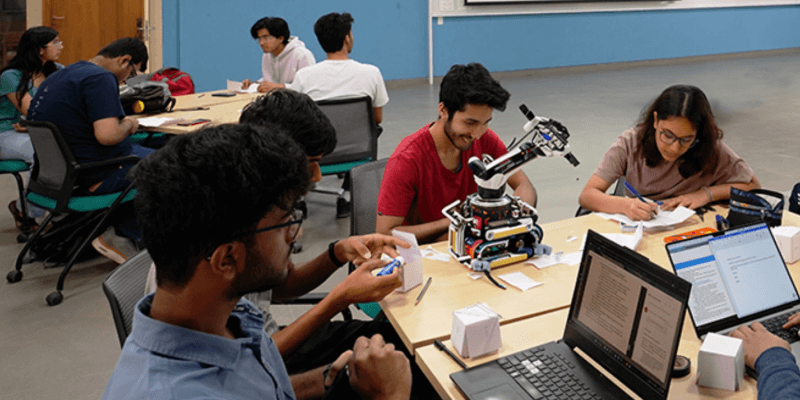Plaksha is a place wherein we reimagine higher education. When I joined Plaksha in March 2023, this was one of the key highlights that motivated me. It was quite exciting to be a part of an institution that is committed to reimagine education, which will be well suited to the needs of the 21st century. At the core of this is the fundamental approach with which we impart education. At Plaksha, we try to foster students’ interest uniquely in a way that enables curiosity-based learning.
Traditionally, classroom instructions are passively delivered. Though the curriculum revolves around some of the biggest inventions that were done in that subject area throughout history there is an inveterate pedagogical path towards teaching those concepts. Textbooks are standardized in terms of topics and sequences and the instructors follow the traditional method of teaching those topics around the textbook content.
We have reimagined this entire pedagogical path to try and do something different. What could be the ambition and vision of any aspiring academic institution, in the technological education space, who want to be on par with leading global institutions and even aspire to beat them? The answer is to be able to produce a new generation of scientific minds that have the caliber, ability, skills and willingness to reshape the world around them through science and technology.
When we think of the most beautiful minds in history, many names come up: Sir Isaac Newton, Aristotle, Galileo, Michael Faraday, Albert Einstein, James Clerk Maxwell, Robert Oppenheimer, Paul Dirac, Richard Feynman, Stephen Hawking, Steve Jobs—the list goes on. However, when we ask whether education systems today can produce such geniuses, the answer is a straightforward no. No matter whether one attends MIT, Stanford, Cambridge, or anywhere else in the world, the possibility of turning a young bright mind into an intellectual genius is next to impossible. There is no mechanism that guarantees this outcome. The reason being that in most of the university-based education systems, including globally recognized institutions, pedagogy is the same—standard courses that students must excel in, often revolving around textbooks content. When solving problems, students typically seek answers that are already present in the textbooks.
Asking meaningful questions that are unanswered in textbooks requires a learning mechanism that goes beyond this. There is an element of experiential learning that provides a glimpse into the scientific minds who invented the concepts we teach. To be able to impart this experiential learning one needs to do things differently. One must dive deep into history and understand the thought processes that might have triggered that same invention mentioned in textbooks. For example, how did Newton come up with his second law of motion? How did Einstein conclude the photoelectric effect mentioned in textbook? How did Fourier develop his Fourier series? Each of these has a remarkable impact on science and technology. This requires going well beyond textbook materials. This also requires understanding the historical context around that invention, knowing exactly what was known and unknown at the time.
We are trying to address precisely this at Plaksha. The Spring '24 semester course on 'Signals and Systems' at Plaksha was designed to offer a wholly curiosity-based teaching-learning experience, akin to how pioneers in this field would have experienced it. Each module was enriched with historical anecdotes and context, encouraging students to think deeply and motivating them to explore further. We had a well curated project on understanding how some of the most mind-blowing inventions that are part of Signals and Systems curriculum were made. A few examples include how Joseph Fourier invented his Fourier series while trying to solve heat equations, how Laplace transform was discovered, and how radio transmission was successfully demonstrated by Jagadish Chandra Bose in Town Hall, Calcutta. Students’ enthusiasm in all these projects and throughout the course was exceptionally good. We look forward to the next academic year filled with such joyful learning experiences.
One of the main highlights of this project was – demonstration of the art of drawing using the Fourier series. The underlying concept is that just by adding sines waves we can create any waveform that we want and hence any art that we want to draw.
Fig 1 shows the project demonstration wherein the students were able to draw the picture of scientist Joseph Fourier through the rotation of complex phasor rods that represent those sine waves. The otherwise complicated pattern of this rotation mechanism is shown in Fig 2. Fig 3 shows the successful attempt of drawing the Plaksha logo through this algorithm. The fact that students were able to fully comprehend the entire science behind this, develop the necessary algorithm and code it from scratch on their own and build appreciation for the subject was one of the major milestones of this teaching pedagogy.



Dr. Vivek Deulkar is Assistant Professor at Plaksha University.



